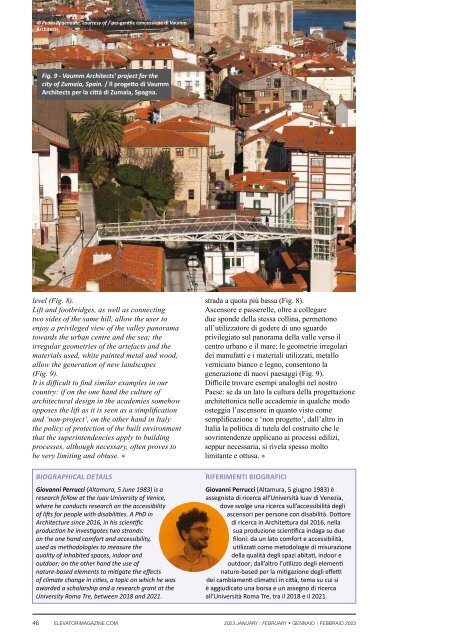Elevatori Magazine 1 - 2023
January - February
January - February
- TAGS
- elevatori magazine
Create successful ePaper yourself
Turn your PDF publications into a flip-book with our unique Google optimized e-Paper software.
© Pedro Pegenaute, courtesy of / per gentile concessione di Vaumm<br />
Architects.<br />
Fig. 9 - Vaumm Architectsʼ project for the<br />
city of Zumaia, Spain. / Il progetto di Vaumm<br />
Architects per la città di Zumaia, Spagna.<br />
level (Fig. 8).<br />
Lift and footbridges, as well as connecting<br />
two sides of the same hill, allow the user to<br />
enjoy a privileged view of the valley panorama<br />
towards the urban centre and the sea; the<br />
irregular geometries of the artefacts and the<br />
materials used, white painted metal and wood,<br />
allow the generation of new landscapes<br />
(Fig. 9).<br />
It is difficult to find similar examples in our<br />
country: if on the one hand the culture of<br />
architectural design in the academies somehow<br />
opposes the lift as it is seen as a simplification<br />
and ‘non-project’, on the other hand in Italy<br />
the policy of protection of the built environment<br />
that the superintendencies apply to building<br />
processes, although necessary, often proves to<br />
be very limiting and obtuse. •<br />
BIOGRAPHICAL DETAILS<br />
Giovanni Perrucci (Altamura, 5 June 1983) is a<br />
research fellow at the Iuav University of Venice,<br />
where he conducts research on the accessibility<br />
of lifts for people with disabilities. A PhD in<br />
Architecture since 2016, in his scientific<br />
production he investigates two strands:<br />
on the one hand comfort and accessibility,<br />
used as methodologies to measure the<br />
quality of inhabited spaces, indoor and<br />
outdoor; on the other hand the use of<br />
nature-based elements to mitigate the effects<br />
of climate change in cities, a topic on which he was<br />
awarded a scholarship and a research grant at the<br />
University Roma Tre, between 2018 and 2021.<br />
strada a quota più bassa (Fig. 8).<br />
Ascensore e passerelle, oltre a collegare<br />
due sponde della stessa collina, permettono<br />
all’utilizzatore di godere di uno sguardo<br />
privilegiato sul panorama della valle verso il<br />
centro urbano e il mare; le geometrie irregolari<br />
dei manufatti e i materiali utilizzati, metallo<br />
verniciato bianco e legno, consentono la<br />
generazione di nuovi paesaggi (Fig. 9).<br />
Difficile trovare esempi analoghi nel nostro<br />
Paese: se da un lato la cultura della progettazione<br />
architettonica nelle accademie in qualche modo<br />
osteggia l’ascensore in quanto visto come<br />
semplificazione e ‘non progetto’, dall’altro in<br />
Italia la politica di tutela del costruito che le<br />
sovrintendenze applicano ai processi edilizi,<br />
seppur necessaria, si rivela spesso molto<br />
limitante e ottusa. •<br />
RIFERIMENTI BIOGRAFICI<br />
Giovanni Perrucci (Altamura, 5 giugno 1983) è<br />
assegnista di ricerca all’Università Iuav di Venezia,<br />
dove svolge una ricerca sull’accessibilità degli<br />
ascensori per persone con disabilità. Dottore<br />
di ricerca in Architettura dal 2016, nella<br />
sua produzione scientifica indaga su due<br />
filoni: da un lato comfort e accessibilità,<br />
utilizzati come metodologie di misurazione<br />
della qualità degli spazi abitati, indoor e<br />
outdoor; dall’altro l’utilizzo degli elementi<br />
nature-based per la mitigazione degli effetti<br />
dei cambiamenti climatici in città, tema su cui si<br />
è aggiudicato una borsa e un assegno di ricerca<br />
all’Università Roma Tre, tra il 2018 e il 2021.<br />
46 ELEVATORIMAGAZINE.COM <strong>2023</strong> JANUARY | FEBRUARY • GENNAIO | FEBBRAIO <strong>2023</strong>













